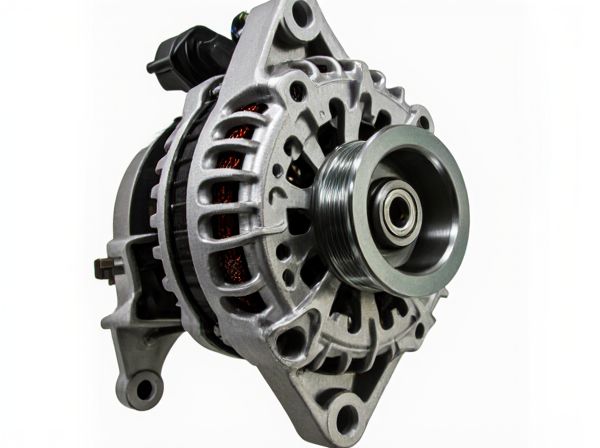
Photo illustration: Heavy Duty Bearing vs Standard Bearing
Heavy duty bearings are designed to withstand higher loads, harsher environments, and longer service intervals compared to standard bearings. They feature enhanced materials, precision engineering, and robust construction to handle extreme stresses and reduce downtime. Choosing the right bearing for your application ensures optimal performance and longevity.
Table of Comparison
| Feature | Heavy Duty Bearing | Standard Bearing |
|---|---|---|
| Durability | High resistance to wear and prolonged lifespan | Standard wear resistance, shorter lifespan |
| Load Capacity | Designed for heavy loads and high stress | Suitable for normal load conditions |
| Heat Resistance | Superior heat dissipation for better performance | Moderate heat resistance |
| Maintenance | Less frequent maintenance required | Requires periodic maintenance |
| Cost | Higher upfront cost but cost-effective long term | Lower initial cost, higher replacement frequency |
| Application | Ideal for commercial vehicles, heavy usage | Best suited for light to medium passenger cars |
Introduction to Bearing Types
Heavy duty bearings are specifically engineered to withstand higher loads, extended operational periods, and harsh environmental conditions compared to standard bearings, which are designed for moderate load applications and typical operating environments. These bearings differ in material composition, internal design, and sealing, influencing their durability, friction levels, and maintenance requirements. Choosing between heavy duty and standard bearings depends on factors like load capacity, speed, temperature range, and application-specific demands in machinery or industrial equipment.
What Defines a Heavy Duty Bearing?
Heavy duty bearings are defined by their ability to support higher loads, endure extreme operating conditions, and provide extended service life compared to standard bearings. These bearings typically feature enhanced materials such as high-grade steel, reinforced cages, and optimized internal clearances to handle increased radial and axial forces. Applications in heavy machinery, construction equipment, and industrial vehicles rely on heavy duty bearings for superior durability and reliability under rigorous stress.
Key Features of Standard Bearings
Standard bearings typically feature moderate load capacity suitable for everyday mechanical applications, providing reliable performance in light to medium-duty environments. They offer versatile sizes and configurations compatible with a broad range of machinery, ensuring ease of replacement and maintenance. Standard bearings generally have lower cost and weight compared to heavy-duty variants, making them optimal for applications where extreme durability is not a primary concern.
Load Capacity Comparison
Heavy duty bearings are engineered to withstand significantly higher load capacities than standard bearings, making them ideal for applications involving heavy machinery or harsh operating conditions. Their design often includes reinforced materials and larger contact surfaces, which distribute stress more effectively and enhance durability under extreme loads. In contrast, standard bearings are suited for moderate load operations and may experience faster wear or failure when subjected to heavy or shock loads.
Durability and Lifespan Differences
Heavy duty bearings exhibit significantly enhanced durability compared to standard bearings due to their reinforced materials and advanced design, allowing them to withstand higher loads and harsher operating conditions. Their lifespan often extends beyond standard bearings by up to 50%, as they resist wear, corrosion, and fatigue more effectively in industrial and heavy machinery applications. Selecting heavy duty bearings ensures optimal performance and reduced maintenance cycles in environments requiring maximum reliability and strength.
Applications: Heavy Duty vs Standard Bearings
Heavy duty bearings are engineered to withstand higher loads and operate in extreme conditions, making them ideal for applications such as construction machinery, mining equipment, and industrial fans. Standard bearings are suitable for lighter loads and moderate environments, commonly used in household appliances, office machinery, and automotive components. Selecting the appropriate bearing type ensures enhanced durability and performance based on specific operational demands.
Material and Construction Differences
Heavy duty bearings are constructed using high-grade steel alloys such as chrome steel or stainless steel to withstand extreme loads and harsh environments, while standard bearings typically use lower-grade steel suitable for moderate load applications. Heavy duty bearings feature reinforced inner and outer rings, thicker raceways, and enhanced sealing systems to provide superior durability, resistance to contamination, and extended service life. The construction differences include precision heat treatment processes and advanced lubricant retention designs in heavy duty bearings, ensuring optimal performance under continuous heavy stress compared to the simpler build of standard bearings.
Maintenance and Cost Considerations
Heavy duty bearings require less frequent maintenance due to their enhanced durability and ability to withstand higher loads and harsh operating conditions, reducing long-term downtime expenses. Although the initial cost of heavy duty bearings is significantly higher than standard bearings, their extended lifespan and lower failure rates often lead to better cost-efficiency in heavy industrial applications. Standard bearings, while cheaper upfront, typically demand more frequent inspections, lubrication, and replacements, increasing maintenance costs over time.
Selection Criteria for Your Application
Heavy duty bearings are designed to handle higher load capacities, impact resistance, and longer service life compared to standard bearings, making them ideal for industrial machinery, construction equipment, and heavy vehicles. Selection criteria should prioritize load type (radial or axial), operating speed, environmental conditions such as temperature and contamination, as well as maintenance intervals. Choosing the right bearing involves evaluating application-specific demands, including load magnitude, shock loads, and reliability requirements to ensure optimal performance and cost-efficiency.
Conclusion: Choosing the Right Bearing
Heavy duty bearings are engineered to withstand higher loads, extreme conditions, and extended operational life compared to standard bearings, making them ideal for industrial machinery and heavy equipment. Standard bearings suit applications with moderate loads and less demanding environments, offering cost-efficiency and adequate performance in everyday machinery. Selecting the right bearing depends on load capacity, environmental conditions, and maintenance requirements to ensure optimal functionality and longevity.
 caratoz.com
caratoz.com